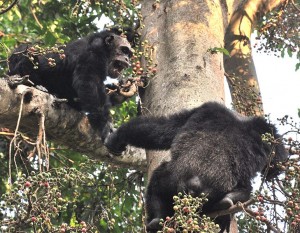Herpes evolution: Jump from chimpanzees to Homo erectus, according to UCSD researchers
NEWS RELEASE
Researchers at the University of California, San Diego School of Medicine have identified the evolutionary origins of human herpes simplex virus (HSV) -1 and -2, reporting that the former infected hominids before their evolutionary split from chimpanzees 6 million years ago while the latter jumped from ancient chimpanzees to ancestors of modern humans –Homo erectus – approximately 1.6 million years ago.

Photo/Caelio via Wikimedia Commons
The findings are published in the June 10 online issue of Molecular Biology and Evolution.
“The results help us to better understand how these viruses evolved and found their way into humans,” said Joel O. Wertheim, PhD, assistant research scientist at the UC San Diego AntiViral Research Center and lead author of the study. “Animal disease reservoirs are extremely important for global public health. Understanding where our viruses come from will help guide us in preventing future viruses from making the jump into humans.”
Approximately two-thirds of the human population is infected with at least one herpes simplex virus. The viruses are most commonly presented as cold sores on the mouth or lips or blisters on the genitals.
“Humans are the only primates we know of that have two herpes simplex viruses,” said Wertheim. “We wanted to determine why.”
The researchers compared the HSV-1 and HSV-2 gene sequences to the family tree of simplex viruses from eight monkey and ape host species. Using advanced models of molecular evolution, the scientists were able to more accurately estimate ancient viral divergence times. This approach allowed them to determine when HSV-1 and HSV-2 were introduced into humans with far more precision than standard models that do not account for natural selection over the course of viral evolution.
The genetics of human and primate herpes viruses were examined to assess their similarity. It became clear that HSV-1 has been present in humans far longer than HSV-2, prompting the researchers to further investigate the origins of HSV-2 in humans.
The viral family tree showed that HSV-2 was far more genetically similar to the herpes virus found in chimpanzees. This level of divergence indicated that humans must have acquired HSV-2 from an ancestor of modern chimpanzees about 1.6 million years ago, prior to the rise of modern humans roughly 200,000 years ago.
“Comparing virus gene sequences gives us insight into viral pathogens that have been infecting us since before we were humans,” said Wertheim.














